Click the blue text to follow us
1
Introduction

With the development of wearable technology, smart bands and watches are becoming increasingly popular in our lives. Common smartwatches can monitor various physiological characteristics of the human body, including heart rate, blood oxygen, and body temperature. Blood pressure is an important physiological parameter in the human circulatory system and is crucial for diagnosing and assessing cardiovascular diseases. In recent years, some smartwatches capable of monitoring blood pressure have emerged, such as Huawei’s WATCH D. However, Apple, with its extensive research experience in wearable devices, has yet to introduce blood pressure monitoring in its Apple Watch. So, what is the principle behind smartwatches measuring blood pressure? What are the technical challenges? This article will answer these questions one by one.
2
Traditional Blood Pressure Measurement Methods

Traditional blood pressure measurement methods primarily include auscultatory and oscillometric methods.
Auscultatory Method: The principle of the auscultatory method is to inflate a cuff to apply pressure to the blood vessels, raising it above the arterial pressure level. As the cuff gradually deflates, the sounds produced by the arterial pulse waves are recorded, known as Korotkoff sounds, as shown in Figure 1. The first Korotkoff sound represents the maximum pressure generated during each cardiac cycle, known as systolic pressure, while the pressure value when the sound disappears completely is the diastolic pressure.
Oscillometric Method: The oscillometric method is an advanced version of the auscultatory method. Like the auscultatory method, it requires a cuff to apply pressure, but it uses an electronic pressure sensor to observe pressure oscillations in the cuff. The electronic device interprets the data automatically and controls the inflation and deflation of the cuff. Most electronic blood pressure monitors use the oscillometric method, as shown in Figure 2.

Figure 1 Auscultatory method for measuring blood pressure
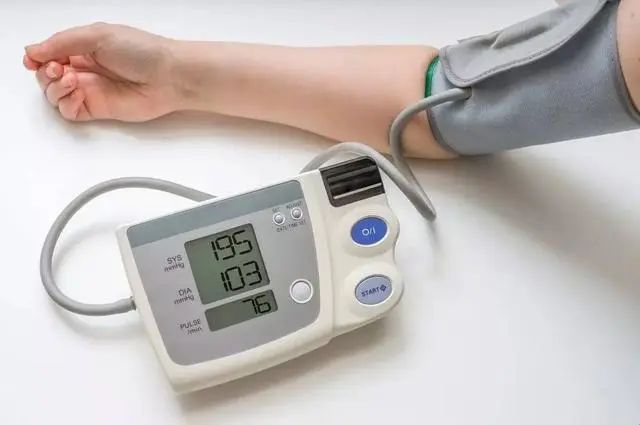
Figure 2 Oscillometric method for measuring blood pressure
Currently, the smartwatches available on the market that have received certification from the National Medical Products Administration for blood pressure measurement predominantly use the traditional oscillometric method, such as Huawei’s WATCH D and Jinyi’s BPW1 smart band, as shown in Figure 3.
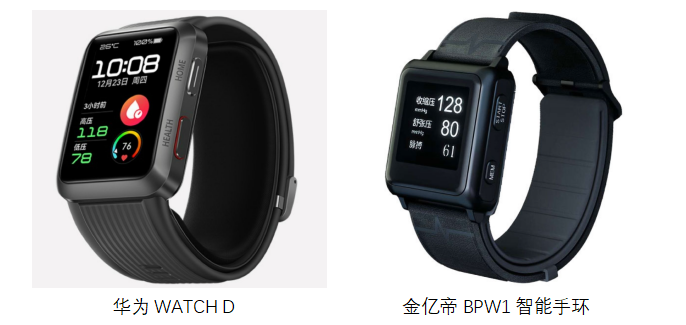
Figure 3 Smart blood pressure watch
The characteristic of this type of smartwatch is that it miniaturizes the traditional cuff into the watch strap, using an airbag within the strap to apply pressure for blood pressure measurement. The downside of such smartwatches is that they cause noticeable discomfort during blood pressure measurement and cannot perform continuous blood pressure monitoring.
So, is there a method to measure blood pressure continuously without the user feeling it? The answer is yes. This method is called Photoplethysmography (PPG).
3
New Blood Pressure Measurement Method — Photoplethysmography

You may have noticed that the back of smartwatches often flashes green light, as shown in Figure 4. This indicates that the PPG sensor is collecting your physiological signals. Most smartwatches on the market use PPG sensors to monitor heart rate.
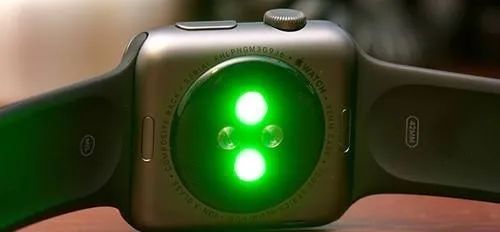
Figure 4 PPG sensor
Photoplethysmography uses the LED in the PPG sensor to emit green light that penetrates the tissue and arteries in the skin, being absorbed and reflected back to the photodiode (PD). Blood differs from muscle, bone, veins, and other connective tissues in that it is fluid, thus its light absorption varies. The obtained light signal is converted into an electrical signal, yielding both direct current (DC) and alternating current (AC) signals, where the AC signal reflects the characteristics of blood flow and related physiological features. The principle is illustrated in Figure 5.
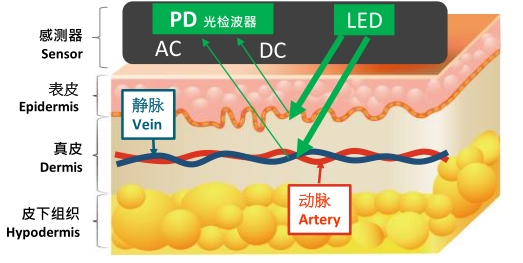
Figure 5 Principle of Photoplethysmography
Photoplethysmography can be divided into methods based on pulse wave velocity and methods based on pulse wave characteristic parameters.
3.1 Blood Pressure Measurement Based on Pulse Wave Velocity
By analyzing the propagation characteristics of pulse waves in the arterial system through pulse wave velocity (PWV), we can understand the relationship between pulse waves and arterial blood pressure. As early as the 19th century, Moens and Korteweg derived the calculation formula for pulse wave velocity from a hemodynamic perspective, known as the M-K equation, as shown in the figure. From the results derived in Figure 4, it can be seen that there is a correlation between pulse transit time (PTT) and blood pressure (BP); with known PTT, blood pressure can be obtained.

Figure 6 Derivation of M-K equation
So, how is the PTT value obtained? In smartwatches, the calculation of pulse wave transit time (PTT) typically requires obtaining two signals: electrocardiogram (ECG) and pulse wave signal (PPG). As shown in Figure 7, PTT is the time interval between the R wave of the ECG and the characteristic point of the PPG.

Figure 7 Method for calculating pulse wave velocity
Once the PTT value is obtained, how is blood pressure calculated? From the M-K equation in Figure 4, it is clear that to accurately calculate blood pressure, additional hemodynamic parameters such as arterial wall thickness and blood density are needed. However, since these parameters are difficult to measure and vary among individuals,
it is not possible to directly calculate blood pressure from PTT. A model needs to be constructed to estimate blood pressure, using a linear regression equation to establish a correction factor that can accurately compute blood pressure.
In 2019, the CareUp smartwatch was launched in the United States, which can be used for real-time blood pressure estimation, as shown in Figure 8. It consists of two PPG sensors: one on the back of the device and one on the front. When in use, the user places their finger on the front sensor, and both sensors collect signals simultaneously, which are then filtered and cross-correlated to obtain the time delay between them, calculating the pulse wave transit time (PTT). The PTT obtained is then input into a linear model to estimate blood pressure.
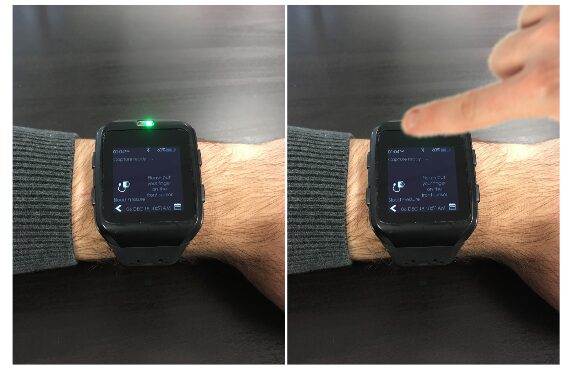
Figure 8 CareUp Smart Blood Pressure Watch
Advantages: The PTT-based blood pressure estimation algorithm is currently a key research direction for cuffless blood pressure measurement, and the theoretical research on this method has matured, with related blood pressure measurement models capable of estimating blood pressure with considerable accuracy.
Disadvantages: This method requires simultaneous acquisition of two signals and needs to keep the signals synchronized. Since the PPG sensor is very sensitive to the wearer’s movement, it can introduce significant noise and motion artifacts into both signals, greatly increasing the difficulty of signal processing.
3.2 Blood Pressure Measurement Based on Pulse Wave Characteristic Parameters
Given the correlation between pulse waves and blood pressure, pulse waves contain a wealth of characteristic information related to blood pressure. The core of the pulse wave characteristic parameter method lies in establishing the relationship between pulse wave characteristic parameters and blood pressure. This method only requires a single-channel PPG signal, from which multiple features are extracted to build a model for estimating blood pressure. The algorithm process is illustrated in Figure 9.

Figure 9 Blood pressure measurement method based on pulse wave characteristic parameters
Due to the complex factors contributing to blood pressure, simply using a linear model cannot effectively describe the nonlinear relationships between parameters and blood pressure. To make the model more realistic and achieve higher measurement accuracy, many studies have adopted neural network models to describe the nonlinear relationship between blood pressure and pulse wave characteristic parameters. Common neural networks include feedforward neural networks like Back-Propagation (BP) neural networks and feedback neural networks like simple RNNs and LSTM models.
Advantages: In the development of smart blood pressure watches, the pulse wave characteristic parameter method has relative advantages, only requiring feature extraction followed by regression model calculation.
Disadvantages: Currently, there is no complete mathematical model that accurately reflects the relationship between blood pressure and pulse wave characteristic parameters. Therefore, statistical methods such as linear regression analysis and neural network methods are used for research, and no mature products have emerged yet.
4
Outlook

The principles discussed above may not seem particularly complex, but why has the blood pressure measurement function not yet become mainstream in smartwatches? The answer is that applying theory to practice still faces some technical challenges:
1. The physiological mechanisms underlying blood pressure generation are not yet fully understood. Methods for estimating blood pressure based on PPG often rely on constructing correlation models between pulse waves and blood pressure. However, since the propagation of pulse waves is influenced by hemodynamic parameters such as vascular compliance, arterial stiffness, and peripheral resistance, changes in arterial blood pressure may not solely be caused by pulse waves, necessitating further research.
2. There are significant individual differences in blood pressure. The correlation coefficient between pulse waves and blood pressure varies among individuals, influenced by factors such as age, gender, and BMI. When establishing blood pressure estimation models, it is essential to minimize the impact of these factors on accuracy and create more universally applicable models.
Nonetheless, photoplethysmography remains a promising technology, with immense potential for providing non-invasive, continuous, and cuffless blood pressure measurement. Researchers have invested considerable effort into this area, as shown in Figure 10. We can look forward to this technology being applied in more smart wearable devices in the near future, offering more possibilities for our healthy lives.

Figure 10 New blood pressure measurement method based on photoplethysmography
(a) A glasses-based device captures pulse waves from the bridge of the nose, synchronously recording ECG signals and ear/nose pulse waves to calculate heart rate and pulse wave transit time (PTT) for blood pressure estimation.
(b) A head-mounted pulse wave collection device analyzes vital signs after collection, estimating blood pressure and also serving as parameters and skeletal tracking data for rehabilitation exercises.
(c) A ring-type PPG signal collection device.
(d) An ear-mounted vital sign monitor that can simultaneously collect ECG and pulse wave signals to estimate blood pressure through algorithms.
Image sources from the internet, please contact for copyright issues.
References:
[1]DING X, ZHANG Y T. Pulse transit time technique for cuffless unobtrusive blood pressure measurement: from theory to algorithm[J/OL]. Biomedical Engineering Letters, 2019, 9(1): 37-52.
[2] DING X R, ZHAO N, YANG G Z, el. Continuous Blood Pressure Measurement From Invasive to Unobtrusive: Celebration of 200th Birth Anniversary of Carl Ludwig[J/OL]. IEEE Journal of Biomedical and Health Informatics, 2016, 20(6): 1455-1465.
[3] Zheng Jiaqiang, Cheng Yunzhang, Bian Junjie. Research Progress on Non-invasive Continuous Blood Pressure Measurement Based on Pulse Wave Characteristic Parameters[J]. Chinese Journal of Medical Physics, 2020, 37(06):749-753.
[4] El-Hajj C, Kyriacou P A. A review of machine learning techniques in photoplethysmography for the non-invasive cuff-less measurement of blood pressure[J]. Biomedical Signal Processing and Control, 2020, 58: 101870.

